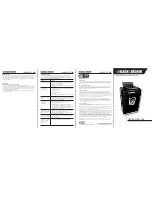
34
3/19
MAINTENANCE
MODEL 12XP CE
GREASE FEEDWHEEL BEARINGS
HYDRAULIC CONTROL VALVES
ELECTRICAL CONTROLS
AIR CLEANER & PRECLEANER
CHECK CLUTCH
TIRES
INSPECT AXLE DUST CAPS
REVIEW ALL SAFETY PROCEDURES ON
DECALS, FROM MANUAL, & FROM VIDEO
Use an EP-2 Lithium type grease only for the
feedwheel bearings. Grease feedwheel bearings
with one shot of grease. This type of bearing is
designed with a relief system that will not allow
over greasing. In other words, you can not hurt the
bearing seals by pumping in too much grease. Most
of the failures related to bearings are diagnosed
as “Contamination”. Contamination is caused by
improper lubrication. Wipe off excess grease.
Excessive grease will attract dirt.
Inspect all hydraulic control valves and ensure they
operate smoothly and shift correctly.
Inspect all electrical controls and switches and
ensure they function properly.
Clean or replace element following engine manual
recommendations. Also, check and clean the
vacuator valve.
Check for proper lubrication, and engagement
tension adjustment, frequently adjust and lubricate
per PTO clutch manufacturer’s manual. Bandit
Industries, Inc. does not warranty clutch failures.
Check tires for wear, air pressure, weather checking
and damage. Replace if damaged. Fill each tire to
rated capacity on tire.
Inspect axle dust caps and replace if damaged or
leaking.
CHECK & OIL FEEDWHEEL SLIDE BOX
Check that the feedwheel slide box is working
smoothly and oil with 10W/30 type motor oil. Clean
and oil the slide guides. After pinning, chaining, and
blocking the top yoke in the up position, clean and
oil each side of the bottom yoke. New machines,
especially, need oiling to ensure correct operation
during break-in.
RADIATOR DEBRIS SCREEN
PERSONAL PROTECTIVE EQUIPMENT
(PPE) IS WORN
Thoroughly clean radiator fins at least once a day
or more in excessive conditions. Make sure debris
is not packed between fins. Use compressed air
and/or pressurized water (soap may also be needed)
to clean the radiator, depending on the level and type
of debris. If pressurized water is used, be careful not
to turn the debris hard and pack solid between the
radiator fins. Make sure to clean the radiator in the
correct direction depending on if the cooling fan is
a sucker or a pusher; do not propel the debris into
the radiator with compressed air or pressurized
water. A partially plugged radiator will not allow the
engine to cool properly. Keep the compressed air or
pressurized water a safe distance from the radiator
fins and parallel to the fins so they are not damaged.
Visually inspect the radiator fins and make sure
they are not bent or closed off, repair or replace as
needed. Clean cooling fan, shroud on air cooled
engines, and the debris screen (if so equipped).
Improper service, maintenance, or neglect will cause
overheating problems and/or engine failure. Refer to
the engine manufacturer’s manual.
DAILY START UP MAINTENANCE
Examples of equipment: hard hat, face shield,
safety glasses, gloves, ear protection, high visibility
vest, and steel toe boots.
















































